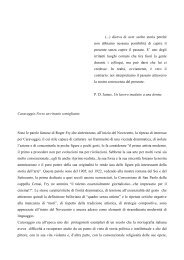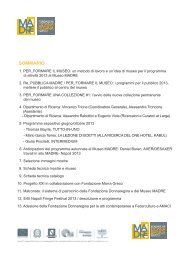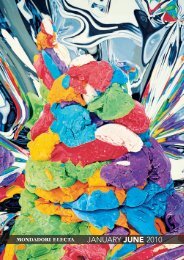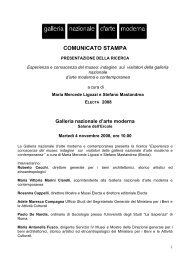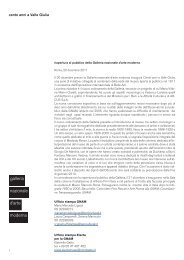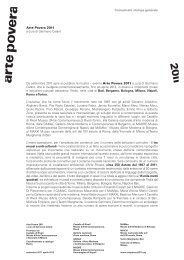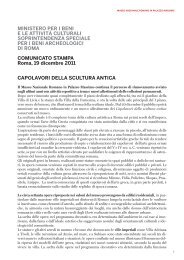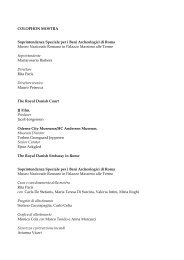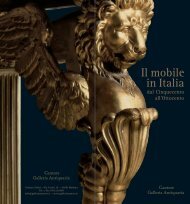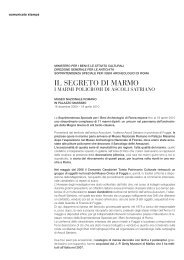Create successful ePaper yourself
Turn your PDF publications into a flip-book with our unique Google optimized e-Paper software.
L’artificiosità e la ricerca del controllo sulla natura<br />
sono alcuni dei principi ispiratori dell’architettura<br />
neroniana che furono applicati nel più celebre tra<br />
i progetti dell’imperatore, la Domus Aurea, una<br />
residenza pensata dallo stesso <strong>Nerone</strong> come cornice<br />
consona alla sua regalità e divinità. La costruzione<br />
iniziò dopo l’incendio del 64, sfruttando in gran<br />
parte le aree rese disponibili proprio dalla catastrofe,<br />
e va inserita nel quadro della pianificazione di<br />
una nuova Roma finalmente adeguata al modello<br />
di Alessandria. Con la Domus Aurea <strong>Nerone</strong><br />
intendeva dunque realizzare una vera e propria<br />
reggia, simile appunto a quelle ellenistiche,<br />
concludendo finalmente l’opera iniziata con la<br />
Domus Transitoria, con cui egli aveva cercato di<br />
riunire gli edifici residenziali che facevano già<br />
parte del suo patrimonio sull’Esquilino (i grandi<br />
giardini imperiali, in primo luogo gli Horti di<br />
Mecenate) e sul Palatino. Il progetto si espanse però<br />
rapidamente fino a includere anche gran parte del<br />
Celio e della Velia, formando quasi una città nella<br />
città. Come scrive Tacito la realizzazione dell’opera<br />
fu affidata a due architetti geniali, Severo e Celere,<br />
che tentarono nello stesso tempo di ridisegnare<br />
intorno alla via Sacra l’aspetto stesso del centro della<br />
capitale dell’impero e, all’interno della Domus, di<br />
rimodellare la natura dei luoghi ricreandovi quei<br />
paesaggi del mito e dell’idillio tipici degli Horti e<br />
amati anche dalla pittura del tempo: nell’enorme<br />
spazio a disposizione le parti costruite affioravano<br />
tra i boschi, giardini e specchi d’acqua, creando così<br />
nuovi suggestivi panorami, incantevoli affacci sui<br />
bacini artificiali e scorci bucolici, probabilmente<br />
“animati” da statue.<br />
R I D I S E G N A R E<br />
I L PA E S AG G I O<br />
R E C R E AT I N G<br />
T H E L A N D S C A P E<br />
50 COLOSSEO<br />
Artifice and an attempt to control nature are two<br />
of the main inspirations of Neronian architecture<br />
applied to the emperor’s most famous project, the<br />
Domus Aurea. This was the residence that Nero<br />
intended to be a suitable backdrop for his regal<br />
majesty and divinity. Construction began after the<br />
fire of AD 64, and made use of the areas cleared by<br />
this catastrophe. It was part of the plan for a new<br />
Rome that finally would be worthy of comparison<br />
with Alexandria. Thus, with the Domus Aurea,<br />
Nero aimed to create a proper palace, like<br />
Hellenistic examples.<br />
This would complete the project that began with<br />
the Domus Transitoria, with which he sought<br />
to unite the residential buildings that belonged<br />
to him on the Esquiline Hill (the great imperial<br />
gardens, and in particular the Horti of Maecenas)<br />
and on the Palatine Hill.<br />
The project quickly expanded to include large<br />
parts of the Caelian and Velian Hills as well,<br />
almost forming a city within a city. Tacitus relates<br />
that the work was entrusted to two brilliant<br />
architects, Severus and Celer. In the same period<br />
they attempted to redesign the appearance of the<br />
centre of the capital of the empire in the area of<br />
the Via Sacra, and, within the Domus, to reshape<br />
the natural character of places to recreate the<br />
mythological and idyllic landscapes typical of the<br />
Horti , also found in paintings of the period. In the<br />
enormous space available, man-made structures<br />
appeared between the woods, gardens and ponds,<br />
creating breathtaking new panoramas, enchanting<br />
views of artificial lakes, and bucolic scenes,<br />
probably peopled by statues.



